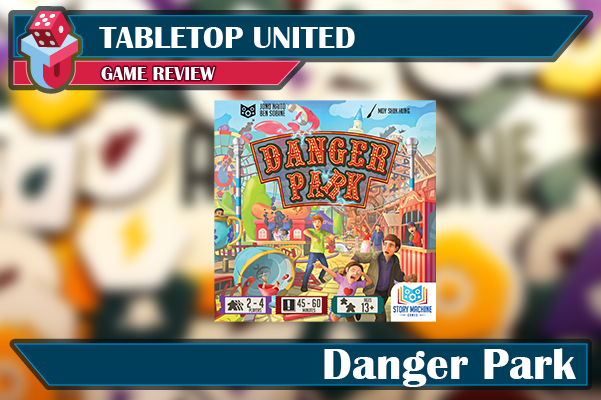
Casualty Rates Within Regulation: A Danger Park Review
Designers: Jono Naito, Ben Sobine
Artists: Moy Shin Hung, Matt Paquette
Publisher: Story Machine Games
Year Published: 2021
No. of Players: 2-4
Ages: 13+
Playing Time: 45-60 minutes
Main mechanic / Theme: Dice Rolling & Stat Checks / Amusement Park & Humor
"I love it when theme and mechanics unite in harmony, and I think Danger Park pulls that off nicely."
Find more info on BoardGameGeek.com
Overview:
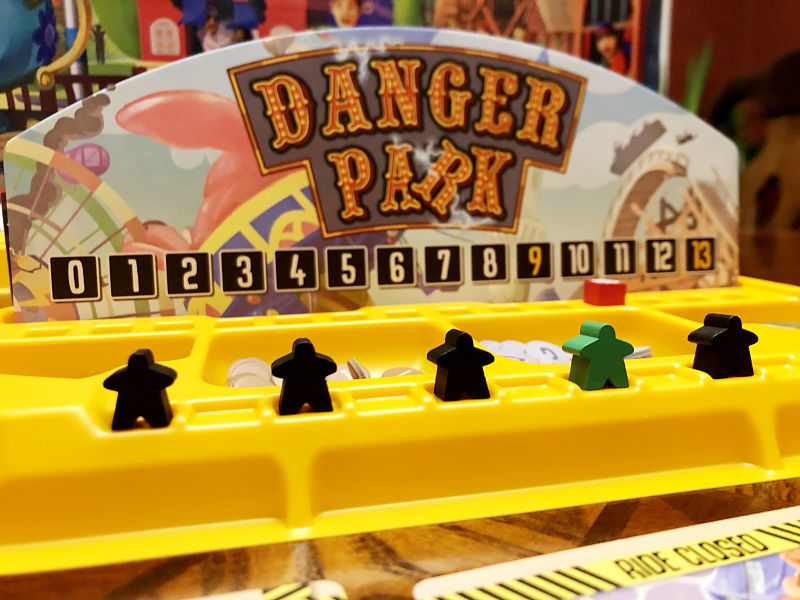
In Danger Park, you and the other players are investors at an Action Park-esque amusement park in which you own individual rides and milk them for all they’re worth before they inevitably close down. Players build and claim rides, add guests, add danger tokens, and roll for ride successes. On failed rolls, bad things happen—sometimes to your ride, sometimes as spillover to other rides. Rides close and patrons get hurt, but in the end, it’s the player with the most money that comes out victorious.
Gameplay and Mechanisms:
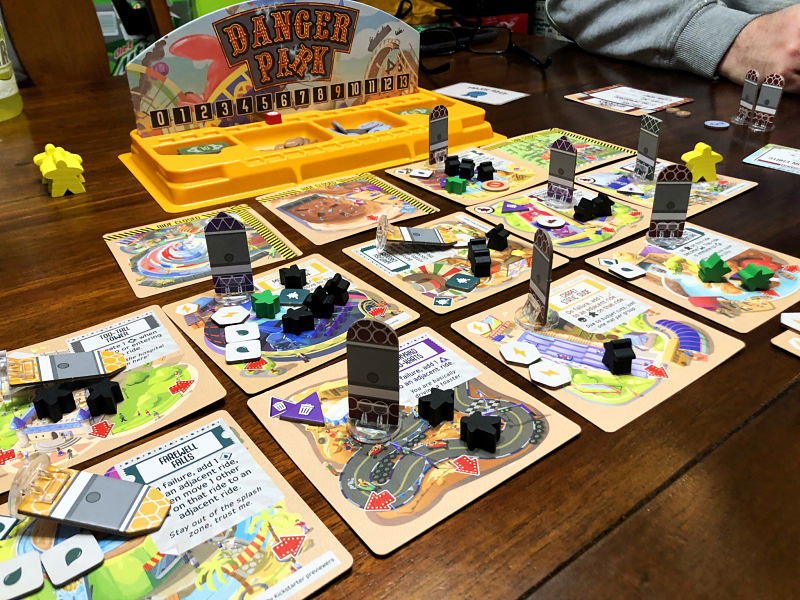
Danger Park is all about building and closing rides, moving patrons (meeples) from one ride to the next, and pushing your rides’ limits to collect as much cash as possible. Each round, players take turns building a new ride in the park (and populating it with a matching danger token and two patrons), rolling for all of their owned rides to see if there are any incidents, and earning money per guest on each of your rides. It sounds straight forward enough, but there’s more.
Each ride has arrows, indicating the specific ways patrons must exit. One die is rolled for each patron on a ride. When a roll is too low (equal to or less than the number of danger tokens on that ride), each failed roll causes one patron to exit the ride, due to dissatisfaction. Failed rolls also increase the danger (i.e. adds a danger token to the ride) of the ride, thereby increasing the number needed for a successful roll in the future. When a roll fails or a ride closes, the patrons exit, and they must follow the arrows on the card. So, where you build your ride will affect where the patrons flow, and if you put it next to your opponents’ rides, you’re giving them extra patrons for their income collection (assuming they stick around). A park closes when there are 4 danger tokens of one type on the ride, or when the ride has 4 different types of danger tokens on it. There are 8 types of danger, including vomit, electrical, trash, infestations (i.e. bugs), grease, and more.
Speaking of vomit, some rides make patrons sick, and they turn into pukers. At the end of each round, pukers gonna puke, and one vomit danger token is added per sick patron. This is a quick way to close down rides, and, honestly, one of the funniest (at least for us). Because if you end up with at least 4 sick patrons on your ride at the end of the round, that ride is closed! But, that’s business in Danger Park.
Every time a ride closes, the incident track increases by one. Every time a patron is “injured” (it’s a skull icon, so I think there’s more going on than simple injuries…), the incident track increases by one. In a regular game, play continues until the 9th incident, after which the round plays through until complete and the game ends. With 4 players (or for a longer game), the incident track must reach 13. At first, the incidents are few and far between. But, as the game progresses, you’ll be “injuring” one or two (and quite possibly more) patrons a round, and closing a number of rides at once. That’s when the game really gets interesting, since everyone is trying to squeeze out the final pennies of their suckers patrons.
The major mechanics in Danger park include map building (i.e. placing new rides), stat checks (i.e. rolling for successful rides, one die rolled per patron per ride), and a heap of “take-that” that comes in the form of events and ride abilities. While there is a lot painful of player interaction, that’s a main part of this game and is one of the major causes of laughter throughout the game. It’s nothing personal, it’s just how the game is played. Realize that and there will be no hard feelings (and if there are, I’m sure they’re totally warranted).
The mechanics fit with the theme in a fun (and, at times, hilarious) way that really creates a cohesive gameplay experience. I love it when theme and mechanics unite in harmony, and I think Danger Park pulls that off nicely.
Theme & Artwork
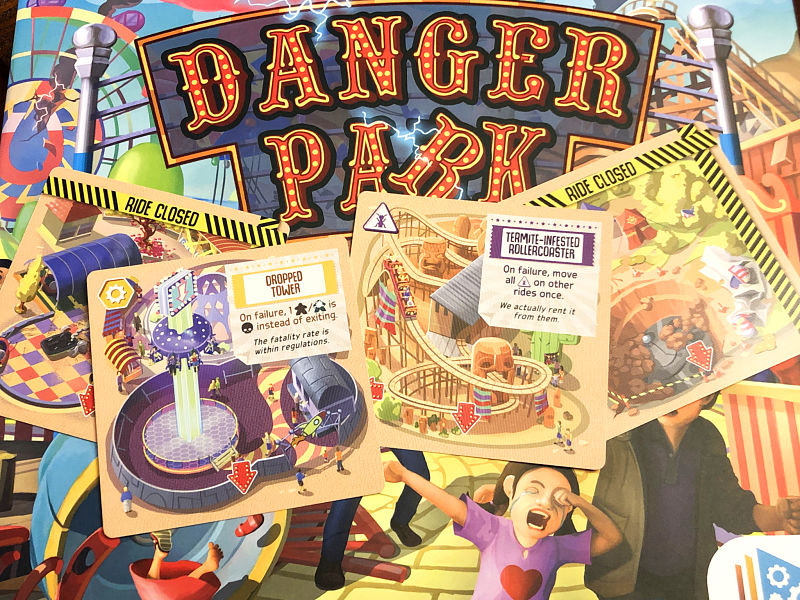
The art showed off the rides as you would expect them to be—sketchy at best, hilariously dangerous at worst. I must say, the art direction was on point for this one, creating immersive imagery for the players to really get a feel of what they’re putting their patrons through (have you no shame?).
Likewise, the flavor text is pretty much mandatory. I mean, the ride and event names are funny and clever as it is, but with the flavor text, it adds a whole new level of amusement. Some standout performances include:
- Unstoppable Bumper Cars: “Anything is a bumper car if you hit it right.”
- Dropped Tower: “The fatality rate is within regulations.”
- Carpet Static Slide: “Due to budget cuts, just one mat per group.”
- Junkyard Go-Karts: “You are basically driving a toaster.”
Don’t forget, the ride names and flavor text are even better with the card art. I do enjoy the absurdist humor laced throughout the game.
Despite the fun times, I do need to comment on the rule book. It is written well and easy to follow (which is great), but the first couple games left us with questions that were not answered in the book. I got the answers from Board Game Geek, where there will be an FAQ posted soon (or so I’m told). Just know that if you’re confused about a rules question, do check BGG for an answer; it’s probably been asked before.
What Worked:
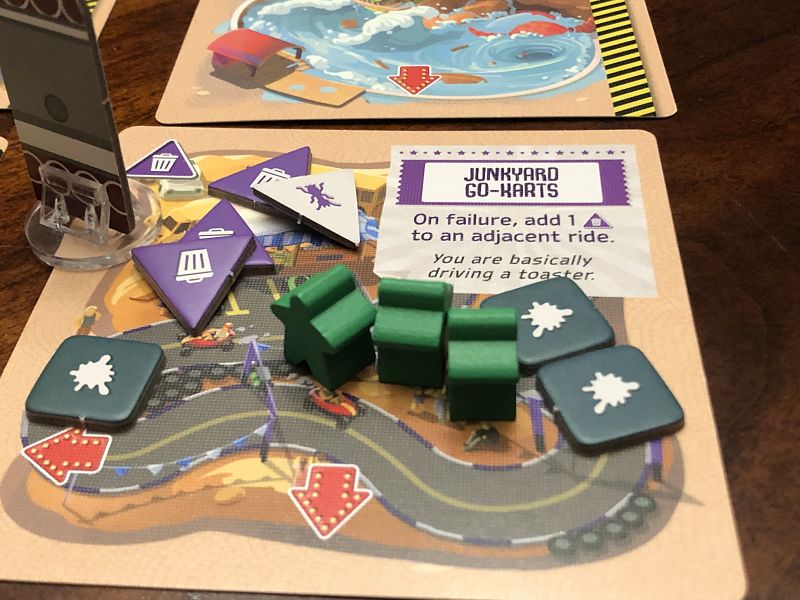
I really enjoyed the dice rolling for failure checks. The more danger tokens, the more difficult the roll. And, the more patrons, the more dice are rolled. It’s a good escalation that makes the game’s pace pick up as the game progresses. And, of course, while the initial check requires rolling higher than 1, it’s always fun when the very first roll for that ride—with two dice for two patrons—the player rolls double 1s. And, yes, that happened. Laughter ensued. So despite the relative ease of success, there’s still a chance your ride will fail miserably. In fact, you can practically count on it.
The way the patrons exit the rides is a big part of the game and is where the most thought goes. It’s like following a flow chart: enter here, exit here, then go here, and finally there. Of course, ride abilities and events can alter the way patrons exit (such as by blocking exits). All of this makes for an interesting game of meeple movement and manipulating it to your advantage.
Final Thoughts:
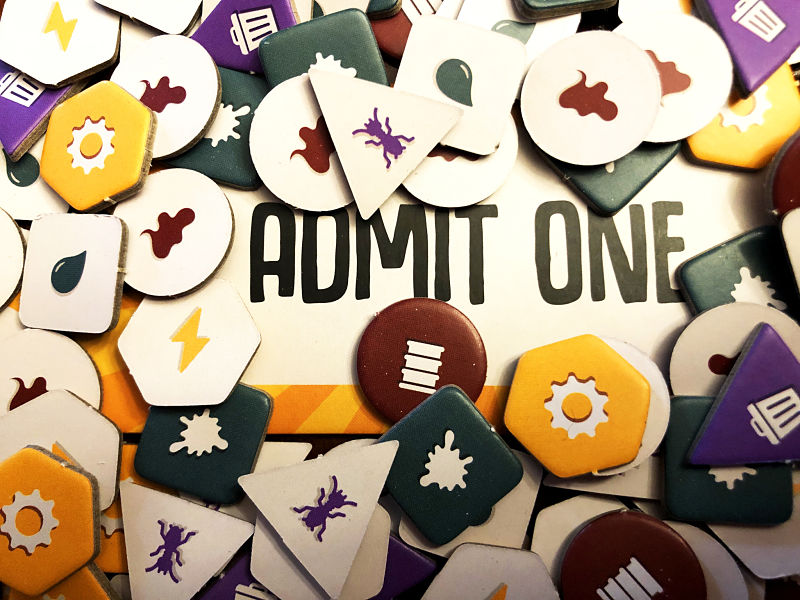
Danger Park is a solid game. Not much to complain about as far as the gameplay goes. It is well done and will appeal to a lot of different types of gamers. While I do enjoy it, it’s probably not going to be my favorite any time soon. For me, it’s a good one to bring out every so often for some light play and laughter, and certainly for when the kids get older—they will almost certainly love the theme and gameplay.
There are other theme/amusement park games out there, such as Unfair, but it’s difficult to compare Danger Park to these games because it is quite different in terms of gameplay, which is a good thing; we don’t need the same games with different names. But if you enjoy Unfair, you may very well like Danger Park (although Danger Park would be lighter fare compared to Unfair). Both games have a fair deal of “take-that,” in which players do dastardly deeds to each other in order to get ahead, including shutting down rides and playing events that hurt the other player(s).
When it comes to possible improvements to the game, I honestly can’t think of any. It is what it is, and that’s a good thing. Everything works smoothly; it’s just a matter of understanding the rules that might make the game more difficult than it should be. That said, the BGG forum is an invaluable tool for getting help with your rules questions.
The luck of the dice can be devastating (remember those double 1s?). And, if one player gets pretty far ahead, there’s doesn’t seem to be much of a chance to slow them down, unless the right events come out or your ride’s ability can hamper them in some way. I noticed that in a couple of games we played, where one player (me, for one of them) would pull ahead and stay ahead.
As far as player count goes, Danger Park is quite good at all player counts. That said, I do think it shines with four players. The park seems to build out larger, and with more players trying to shut down other players’ rides, there are more chances to be adversely affected. I do prefer it at four players, yes, but I wouldn’t hesitate to play it at three or two players, either.
All in all, Danger Park is a great game. It will certainly be a game some people would want to avoid, due to its less-than-friendly player interaction, but it will be a hit with even more. As one member of our game group put it, he always appreciates a game he enjoys while losing. And lose he did. But the mechanics and theme make for a fun, entertaining experience, regardless of how bad you’re doing. And that, right there, is the sign of a successful game design.

Benjamin hails from Canada but now lives in Kentucky with his wife and kids. He’s a certified copyeditor and a freelance writer and editor, covering everything from board game rule books to novels. An avid writer of science fiction and fantasy, it comes as no surprise that his favorite board games are those with rich, engaging themes. When he’s not writing or playing games, Benjamin loves to play ultimate Frisbee, watch and play rugby, and read the most epic fantasy books available. Follow him on Twitter @BenjaminKocher and Instagram @Benjamin_Kocher. You can also read his board game inspired fiction at BoardGameImmersion.com.

